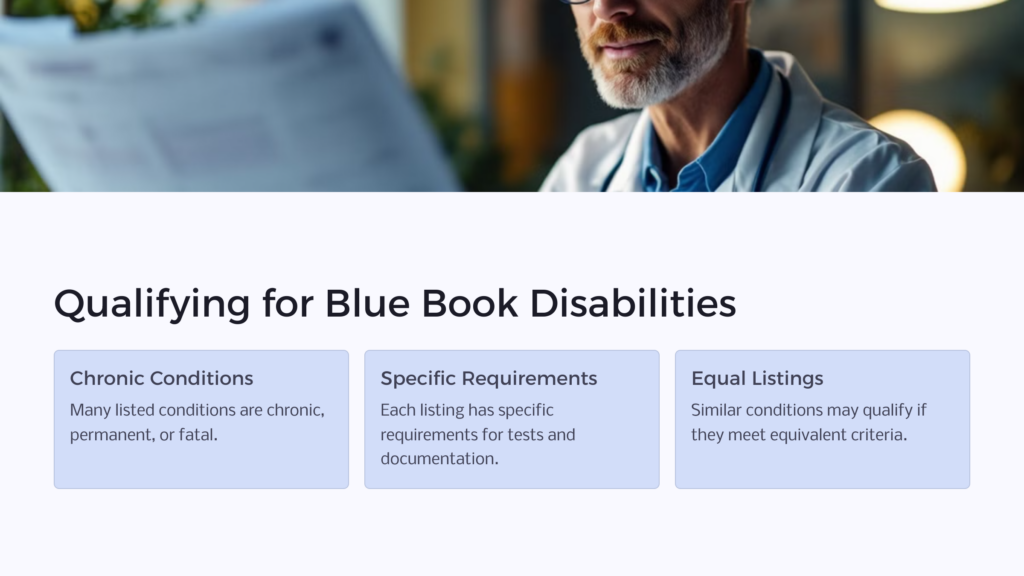If you file for disability benefits either through Social Security Disability Insurance (SSDI) or Supplemental Security Income (SSI), your application will go through a rigorous process to make sure that you are qualified to receive benefits.

While there are many things that go into an application review, far and away the most critical of these is the supporting medical evidence that you submit in an attempt to prove your condition truly meets the standards required.
Once you submit your application, it is reviewed by a claims examiner and a medical consultant. A five-step sequential evaluation process is used to determine if a person meets disability requirements. Those steps are:
- the claimant’s current work activity
- the severity of his or her impairment
- a determination of whether his or her impairments meets or medically equals a listing in the Blue Book
- the claimant’s ability to perform past relevant work
- the ability to do other work based on age, education, and work experience.
Based on their findings, you will either be approved for benefits, or you will be denied and will have to go through the appeals process to overturn your denial. Approval or denial all hinges on whether or not your condition is considered a qualifying disability or not.
There are two processes Social Security uses to determine if an applicant has a qualifying disability or not.

The Blue Book of Impairments. Commonly referred to as just the Blue Book, Social Security bases many of their decisions about applications on whether or not a disability is listed in this document. It lists in great detail, all the qualifying conditions that automatically meet the standards by which Social Security determines whether or not a condition can be qualified as a disability.
 Many of the conditions listed in the Blue Book are either chronic, permanent or fatal. When a disability is listed in the Blue Book, it makes approval of an application much more simple, assuming that an applicant meets all of the other requirements and they submit sufficient evidence that proves the existence of a Blue Book disability. It’s important to note that although a person does have a disability listed in the Blue Book, many people with these conditions are still rejected. The reason why is that within each listing, there are specific requirements that must be met in terms of the types of tests required to document the disability.
Many of the conditions listed in the Blue Book are either chronic, permanent or fatal. When a disability is listed in the Blue Book, it makes approval of an application much more simple, assuming that an applicant meets all of the other requirements and they submit sufficient evidence that proves the existence of a Blue Book disability. It’s important to note that although a person does have a disability listed in the Blue Book, many people with these conditions are still rejected. The reason why is that within each listing, there are specific requirements that must be met in terms of the types of tests required to document the disability.
The Blue Book is divided into two sections. Part A is a listing of all the Adult Listings and is broken into the following major categories:
- Musculoskeletal System
- Special Senses and Speech
- Respiratory System
- Cardiovascular System
- Digestive System
- Genitourinary Disorders
- Hematological Disorders
- Skin Disorders
- Endocrine Disorders (including but not limited to)
- Congenital Disorders that Affect Multiple Body Systems
- Neurological
- Mental Disorders
- Cancer
- Immune System Disorders
Part B is a listing for all the Childhood Listings and is broken into the following major categories:
- Low Birth Weight and Failure to Thrive
- Musculoskeletal System
- Special Senses and Speech
- Respiratory System
- Cardiovascular System
- Digestive System
- Genitourinary Disorders
- Hematological Disorders
- Skin Disorders
- Endocrine Disorders
- Congenital Disorders that Affect Multiple Body Systems
- Neurological
- Mental Disorders
- Cancer
- Immune System Disorders
If a disability is not specifically listed in the Blue Book, Social Security may allow what is known as an equal listing. This is because it can’t list every possible variant of a severe disability and recognizes that there may be several ways to diagnose the same condition. Some Blue Book listings require very specific tests to confirm a disability, but if a person did not take that test and instead took a similar test, it may be good enough to document the disability.

Medical Vocational Allowance. If your condition is not listed in the Blue Book, you still have another way to gain benefits. Obtaining a Medical Vocational Allowance means that you will need to go through all five steps of the sequential evaluation process. A claims examiner will take a close look at both your medical records and your work history to see if you are still capable of performing the same work, or another type of work based on your current job skills, age, education, mental capacity and how well you are currently able to function in a work environment.
If it is determined that you can still perform gainful work, you will probably be denied benefits. However, if it is determined after performing a residual functional capacity assessment that confirms the severity of the limitations, and that a person is not capable of doing their previous work or another kind of work, they can be approved on the basis of a Medical Vocational Allowance.
Just as it is with trying to get qualified for benefits based on a disability that is in the Blue Book, the key to getting benefits based on a Medical Vocational Allowance is that you have gathered and submitted detailed medical and work records. Social Security will want to see work records dating back 15 years so that they can match the type of work you may be able to do with the type of work you were able to do in the past.
 Benefits.com Advisors
Benefits.com Advisors
With expertise spanning local, state, and federal benefit programs, our team is dedicated to guiding individuals towards the perfect program tailored to their unique circumstances.
Rise to the top with Peak Benefits!
Join our Peak Benefits Newsletter for the latest news, resources, and offers on all things government benefits.




















